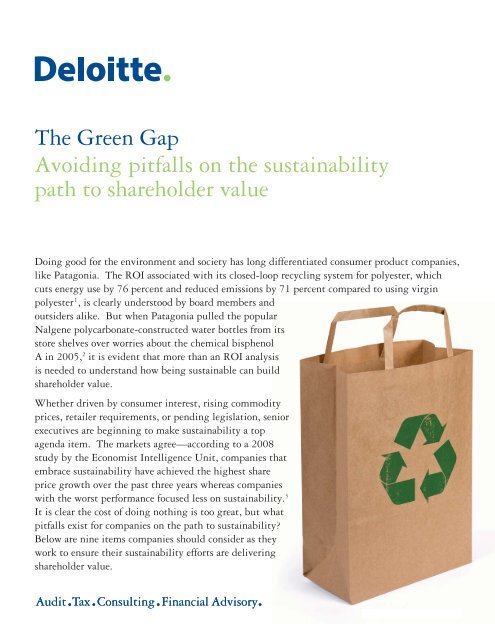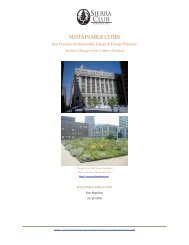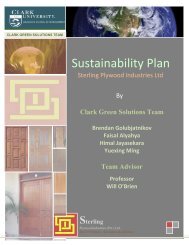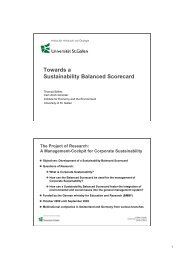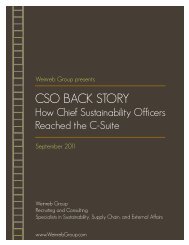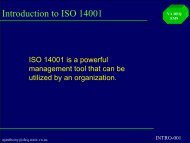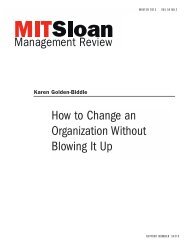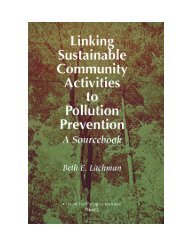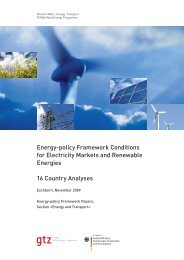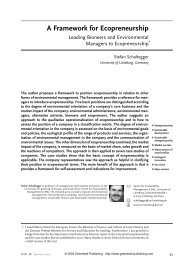The Green Gap Avoiding pitfalls on the sustainability path ... - Deloitte
The Green Gap Avoiding pitfalls on the sustainability path ... - Deloitte
The Green Gap Avoiding pitfalls on the sustainability path ... - Deloitte
You also want an ePaper? Increase the reach of your titles
YUMPU automatically turns print PDFs into web optimized ePapers that Google loves.
<str<strong>on</strong>g>The</str<strong>on</strong>g> <str<strong>on</strong>g>Green</str<strong>on</strong>g> <str<strong>on</strong>g>Gap</str<strong>on</strong>g><str<strong>on</strong>g>Avoiding</str<strong>on</strong>g> <str<strong>on</strong>g>pitfalls</str<strong>on</strong>g> <strong>on</strong> <strong>the</strong> <strong>sustainability</strong><strong>path</strong> to shareholder valueDoing good for <strong>the</strong> envir<strong>on</strong>ment and society has l<strong>on</strong>g differentiated c<strong>on</strong>sumer product companies,like Patag<strong>on</strong>ia. <str<strong>on</strong>g>The</str<strong>on</strong>g> ROI associated with its closed-loop recycling system for polyester, whichcuts energy use by 76 percent and reduced emissi<strong>on</strong>s by 71 percent compared to using virginpolyester 1 , is clearly understood by board members andoutsiders alike. But when Patag<strong>on</strong>ia pulled <strong>the</strong> popularNalgene polycarb<strong>on</strong>ate-c<strong>on</strong>structed water bottles from itsstore shelves over worries about <strong>the</strong> chemical bisphenolA in 2005, 2 it is evident that more than an ROI analysisis needed to understand how being sustainable can buildshareholder value.Whe<strong>the</strong>r driven by c<strong>on</strong>sumer interest, rising commodityprices, retailer requirements, or pending legislati<strong>on</strong>, seniorexecutives are beginning to make <strong>sustainability</strong> a topagenda item. <str<strong>on</strong>g>The</str<strong>on</strong>g> markets agree—according to a 2008study by <strong>the</strong> Ec<strong>on</strong>omist Intelligence Unit, companies thatembrace <strong>sustainability</strong> have achieved <strong>the</strong> highest shareprice growth over <strong>the</strong> past three years whereas companieswith <strong>the</strong> worst performance focused less <strong>on</strong> <strong>sustainability</strong>. 3It is clear <strong>the</strong> cost of doing nothing is too great, but what<str<strong>on</strong>g>pitfalls</str<strong>on</strong>g> exist for companies <strong>on</strong> <strong>the</strong> <strong>path</strong> to <strong>sustainability</strong>?Below are nine items companies should c<strong>on</strong>sider as <strong>the</strong>ywork to ensure <strong>the</strong>ir <strong>sustainability</strong> efforts are deliveringshareholder value.1
Pitfall #1: C<strong>on</strong>fusi<strong>on</strong> from <strong>the</strong> startSustainability is often left open to interpretati<strong>on</strong> as it remains a broadand complex c<strong>on</strong>cept that has not been c<strong>on</strong>sistently defined. <str<strong>on</strong>g>The</str<strong>on</strong>g>UN Brundtland Commissi<strong>on</strong> developed <strong>on</strong>e of <strong>the</strong> first definiti<strong>on</strong>s of<strong>sustainability</strong>: “Sustainable development is development that meets<strong>the</strong> needs of <strong>the</strong> present without compromising <strong>the</strong> ability of futuregenerati<strong>on</strong>s to meet <strong>the</strong>ir own needs.” However, <strong>the</strong> Commissi<strong>on</strong>’sdefiniti<strong>on</strong> has not been c<strong>on</strong>sistently adopted by companies, thuscomplicating <strong>the</strong> <strong>sustainability</strong> landscape. For example, corporate philanthropicefforts to protect <strong>the</strong> envir<strong>on</strong>ment or improve <strong>the</strong> c<strong>on</strong>diti<strong>on</strong>sof local communities often get cited as examples of <strong>sustainability</strong>. Lessobvious comp<strong>on</strong>ents of <strong>sustainability</strong> are efforts to mitigate raw materialshortages or to improve corporate governance and transparency.Despite <strong>the</strong> c<strong>on</strong>fusi<strong>on</strong>, it is becoming comm<strong>on</strong>ly accepted that <strong>sustainability</strong>encompasses <strong>the</strong> triple bottom line, including envir<strong>on</strong>mental,social and ec<strong>on</strong>omic factors. <str<strong>on</strong>g>The</str<strong>on</strong>g> strategic opportunity for <strong>sustainability</strong>is at <strong>the</strong> intersecti<strong>on</strong> of all three—c<strong>on</strong>sidering both <strong>the</strong> envir<strong>on</strong>mentaland social implicati<strong>on</strong>s while c<strong>on</strong>tinuing to build shareholdervalue. Where this may become tricky is when <strong>the</strong> envir<strong>on</strong>mental orsocial benefits outweigh <strong>the</strong> short-term financial bottom line.N<strong>on</strong>e<strong>the</strong>less, defining <strong>sustainability</strong> is a critical first step to leveragingit as part of an enterprise’s strategy. Employees need to clearly understandwhat it means—and does not mean—to help <strong>the</strong> salesforce,product managers, and public relati<strong>on</strong>s departments speak to externalparties in a meaningful way. It also can help product engineers andoperati<strong>on</strong>s managers design products and processes while c<strong>on</strong>sidering<strong>the</strong> triple bottom line. Though many organizati<strong>on</strong>s have used <strong>the</strong>UN Brundtland Commissi<strong>on</strong>’s definiti<strong>on</strong> as a starting point for <strong>the</strong>ir<strong>sustainability</strong> definiti<strong>on</strong>, a more narrow definiti<strong>on</strong> may be requireddepending <strong>on</strong> a company’s culture.Pitfall #2: <str<strong>on</strong>g>The</str<strong>on</strong>g> missing link—organizati<strong>on</strong>al DNADefining <strong>sustainability</strong> is a critical first step, but a definiti<strong>on</strong> al<strong>on</strong>e isn’tenough. A <strong>sustainability</strong> visi<strong>on</strong> statement should also be developedin order to serve as a guide for decisi<strong>on</strong>-making related to strategicissues, such as capital projects or merger/acquisiti<strong>on</strong> targeting, as wellas tactical issues including supplier requirements for back-office supplies.By having an inspiring, acti<strong>on</strong>-oriented <strong>sustainability</strong> visi<strong>on</strong> statement,a company can fur<strong>the</strong>r engage its employees and stakeholders.Such engagement is <strong>the</strong> first step in embedding <strong>sustainability</strong> within<strong>the</strong> company’s culture. C<strong>on</strong>sider Patag<strong>on</strong>ia’s unique <strong>sustainability</strong>visi<strong>on</strong>: “Lead an examined life. Clean up our act. Do our penance.Support civil democracy. Influence o<strong>the</strong>r companies.”A company’s missi<strong>on</strong> statement comm<strong>on</strong>ly defines <strong>the</strong> organizati<strong>on</strong>itself—so important, that it is sometimes referred to as <strong>the</strong> company’sDNA. With something so central to a company’s being, it is criticalthat <strong>the</strong> <strong>sustainability</strong> visi<strong>on</strong> statement aligns closely with <strong>the</strong> company’smissi<strong>on</strong> statement. For example, SC Johns<strong>on</strong>’s missi<strong>on</strong> statementand <strong>sustainability</strong> visi<strong>on</strong> share an unmistakable “family values” link:• Missi<strong>on</strong> Statement: Through five generati<strong>on</strong>s of family leadership,SC Johns<strong>on</strong> has become a leading c<strong>on</strong>sumer products company tha<strong>the</strong>lps improve quality of life for families around <strong>the</strong> world.• Sustainability Visi<strong>on</strong> Statement: SC Johns<strong>on</strong> is committed todoing what’s right. As a family company, we care about everyfamily. From <strong>the</strong> products you use, to <strong>the</strong> air you brea<strong>the</strong>, to <strong>the</strong>community you live in, we’re working to make this world a cleaner,healthier, better place…today, for <strong>the</strong> next generati<strong>on</strong> and bey<strong>on</strong>d.Based <strong>on</strong> <strong>the</strong> statements above, it is clear to both employees andexternal stakeholders that <strong>sustainability</strong> is a natural extensi<strong>on</strong> of SCJohns<strong>on</strong>’s core missi<strong>on</strong>.Pitfall #3: Pursuing withoutprioritiesSustainability is a large, strategic issue that can impact multiple areasof an enterprise. Taking <strong>on</strong>e large envir<strong>on</strong>mental challenge head-<strong>on</strong>,such as water c<strong>on</strong>sumpti<strong>on</strong> and quality, can require significant resources.Taking <strong>on</strong> many challenges <strong>on</strong> a smaller scale can dilute <strong>the</strong>desired envir<strong>on</strong>mental benefits or worse, and it can also c<strong>on</strong>fuse keystakeholders about what is really important to <strong>the</strong> enterprise. Developingclear priorities can help decisi<strong>on</strong>-making when <strong>the</strong> ROI is foggyor <strong>the</strong> payback appears fur<strong>the</strong>r out. Hybrid vehicles, for example, canimprove fuel efficiency and reduce greenhouse gas emissi<strong>on</strong>s for largefleet owners. However, <strong>the</strong>se vehicles can cost over $70,000—at least75 percent more than c<strong>on</strong>venti<strong>on</strong>al vehicles—sometimes requiringover a 10-year payback for <strong>the</strong> fuel savings differential. 4 <str<strong>on</strong>g>The</str<strong>on</strong>g> investmentin <strong>the</strong>se vehicles may not meet a company’s payback period, but<strong>the</strong> l<strong>on</strong>g-term cost of not taking <strong>sustainability</strong> seriously may be as c<strong>on</strong>siderableas <strong>the</strong> short-term cost of adopting <strong>sustainability</strong> initiatives. 5Defining priorities requires analyzing <strong>the</strong> enterprise’s inputs and outputsat <strong>the</strong> operati<strong>on</strong>al level. In assessing its inputs, a company mayc<strong>on</strong>sider its top spend categories for raw materials. Accordingly, assome commodities experience increasing levels of volatility, companiesmay elect to make <strong>the</strong>m a higher priority for both envir<strong>on</strong>mentand ec<strong>on</strong>omic benefits. For example, our oil-based ec<strong>on</strong>omy presentschallenges for almost every sector when <strong>the</strong> Energy Informati<strong>on</strong>Administrati<strong>on</strong> (“EIA”) predicts that “tight fundamentals, evidencedby low available surplus capacity and OECD inventories that are belowfive-year average levels, [will] c<strong>on</strong>tinue to put upward pressure <strong>on</strong> oilprices” for 2008. 6 <str<strong>on</strong>g>The</str<strong>on</strong>g> cost volatility of oil thus may spur <strong>on</strong> a companyto place energy management at <strong>the</strong> top of its strategic priorities.22As used in this document, “<strong>Deloitte</strong>” means <strong>Deloitte</strong> C<strong>on</strong>sulting LLP, a subsidiary of <strong>Deloitte</strong> LLP. Please see www.deloitte.com/us/about for a detailed descripti<strong>on</strong> of <strong>the</strong> legal structure of <strong>Deloitte</strong> LLP andits subsidiaries. Note: While a company’s delivery model will affect its opportunities, <strong>the</strong> target areas suggested in this paper are model-agnostic and, <strong>the</strong>refore, relatively appropriate for any CPG company.
On <strong>the</strong> o<strong>the</strong>r hand, stakeholder c<strong>on</strong>cerns can compel companies to reduce<strong>the</strong> outputs generated from operati<strong>on</strong>s. For example, c<strong>on</strong>sumersare becoming increasingly aware of <strong>the</strong> negative impacts of greenhousegas emissi<strong>on</strong>s, escalating <strong>the</strong> pressure <strong>on</strong> companies to reduce<strong>the</strong>ir emissi<strong>on</strong>s levels. As such, reducti<strong>on</strong> of emissi<strong>on</strong>s has emergedas a top priority for many companies as well as <strong>the</strong> related causes ofemissi<strong>on</strong>s, such as energy and transportati<strong>on</strong>.Social issues need to be c<strong>on</strong>sidered as priorities as well, especially forc<strong>on</strong>sumer businesses which have brands to build and protect. Manytimes, <strong>the</strong>se social priorities align closely with <strong>the</strong> brand portfolio’starget markets. Estee Lauder has taken up breast cancer awareness asits cause-related marketing issue of choice to address a public healthissue directly impacting its target market—women. Founded byEvelyn Lauder, <strong>the</strong> Breast Cancer Research Foundati<strong>on</strong> developed <strong>the</strong>ic<strong>on</strong>ic pink ribb<strong>on</strong> and has raised more than $180 milli<strong>on</strong> to date with<strong>the</strong> support of o<strong>the</strong>r c<strong>on</strong>sumer businesses such as Ann Taylor. 7McD<strong>on</strong>ald’s “Balanced, Active Lifestyles” program serves as ano<strong>the</strong>rexample of <strong>the</strong> importance of social priorities. To target <strong>the</strong> growingprevalence of obesity in America where c<strong>on</strong>sumers spent $110 billi<strong>on</strong><strong>on</strong> fast food in 2000 8 , <strong>the</strong> program offers a three-pr<strong>on</strong>ged approach 9 :• Increase menu choice by adding healthier food and beverageopti<strong>on</strong>s, such as fruits, vegetables, fruit juices, and water bottles• Offer nutriti<strong>on</strong>al informati<strong>on</strong> to help diners achieve <strong>the</strong>ir well-beinggoals• Promote physical activity for children and familiesAs <strong>on</strong>e of <strong>the</strong> best known brands in <strong>the</strong> world, McD<strong>on</strong>ald’s soughtto use its brand stature to influence Americans’ eating habits. Forexample, a survey of American children showed that 96 percent couldaccurately identify R<strong>on</strong>ald McD<strong>on</strong>ald with Santa Claus as <strong>the</strong> <strong>on</strong>lyo<strong>the</strong>r character that was better recognized. 10 Accordingly, McD<strong>on</strong>ald’salso transformed its mascot, R<strong>on</strong>ald McD<strong>on</strong>ald, into an ambassadorfor health to promote fur<strong>the</strong>r its “Balanced, Active Lifestyles”message. 11Pitfall #4: Baseless progress85 percent of leading C<strong>on</strong>sumer Businesses have pursued some sortof <strong>sustainability</strong>-related initiative 12 —whe<strong>the</strong>r to streamline producti<strong>on</strong>processes to reduce raw material inputs or retrofit lighting fixtures touse lower energy bulbs. However, what is critically lacking, in manycases, are established baselines against which year-<strong>on</strong>-year benefitscan be measured. It is <strong>on</strong>e thing to tell <strong>the</strong> Board of Directors that<strong>sustainability</strong> is an integral comp<strong>on</strong>ent of <strong>the</strong> company’s strategy orthat $10 milli<strong>on</strong> was invested in energy saving technology; however,it is ano<strong>the</strong>r and far more powerful message to communicate thatmanufacturing waste was reduced by 45 percent since 1998 like Nikedelivered. 13 Bey<strong>on</strong>d missing an opportunity to more effectively engagewith key stakeholders, it is also difficult to pursue state or federal taxincentives associated with lowering envir<strong>on</strong>mental impact withoutbaseline data.Generally speaking, baselines should be established for each key<strong>sustainability</strong> priority. On <strong>the</strong> c<strong>on</strong>sumpti<strong>on</strong> side, this might includewater, energy, pulp, recycled or agricultural inputs, while <strong>the</strong> disposalside might include greenhouse gas emissi<strong>on</strong>s, waste water, scrapwaste and recycled waste. Measuring some of <strong>the</strong>se inputs/outputsis relatively straightforward depending <strong>on</strong> data availability and quality;for example, electricity is generally measured in kilowatt hours and <strong>the</strong>data can be aggregated from electricity utility companies.A more difficult baseline to establish involves measuring greenhousegas emissi<strong>on</strong>s, an issue that has been garnering increased public attenti<strong>on</strong>.To aid companies with determining <strong>the</strong>ir greenhouse gas emissi<strong>on</strong>sinventory, <strong>the</strong> <str<strong>on</strong>g>Green</str<strong>on</strong>g>house Gas Protocol developed an accountingframework that provides guidelines and models that are availablefor free <strong>on</strong> its website. 14 Although both companies and governmentshave relied <strong>on</strong> <strong>the</strong> GHG Protocol standard, it has not been establishedas an official methodology. <str<strong>on</strong>g>The</str<strong>on</strong>g> lack of a formally sancti<strong>on</strong>ed frameworkfor calculating GHG emissi<strong>on</strong>s currently precludes <strong>the</strong> opportunityto accurately assess emissi<strong>on</strong>s levels across companies.Ano<strong>the</strong>r opti<strong>on</strong> that companies have been pursuing is to collaboratewith <str<strong>on</strong>g>The</str<strong>on</strong>g> Carb<strong>on</strong> Disclosure Project (“CDP”). CDP is an independentn<strong>on</strong>-profit organizati<strong>on</strong> that is measuring companies’ emissi<strong>on</strong>s levelsby ga<strong>the</strong>ring voluntary data via questi<strong>on</strong>naire. However, despite <strong>the</strong>large number of resp<strong>on</strong>ses received—77 percent of Fortune 500 companiesand 1,300 corporati<strong>on</strong>s answered <strong>the</strong> questi<strong>on</strong>naire in 2007 15—CDP’s methodology and processes are not subject to third-partyscrutiny. 16 N<strong>on</strong>e<strong>the</strong>less, CDP has also launched a joint effort with Wal-Mart to measure energy use and envir<strong>on</strong>mental effects throughout itsentire supply chain. 17Pitfall #5: Lifecycle AnalysisParalysisLifecycle assessments can be a powerful tool to compare <strong>the</strong> range ofenvir<strong>on</strong>mental impacts al<strong>on</strong>g <strong>the</strong> value chain for a particular productin order to select opti<strong>on</strong>s with <strong>the</strong> least impact. However, <strong>the</strong> lack ofa standardized methodology and trained resources may often preventmeaningful results. In additi<strong>on</strong>, <strong>the</strong> resource and time requirementsto c<strong>on</strong>duct a thorough analysis across a company’s product lines couldbe significant. A full lifecycle assessment may not be ideal for companiesthat lack <strong>the</strong> resources or <strong>the</strong> technical capabilities in <strong>the</strong> initialphase of developing a <strong>sustainability</strong> acti<strong>on</strong> plan. Ra<strong>the</strong>r, an alternativeto a full lifecycle assessment is to create a “<strong>sustainability</strong> index” as aninternal tool to evaluate each product line against <strong>the</strong> o<strong>the</strong>rs based <strong>on</strong>products’ <strong>sustainability</strong> attributes and overall value to <strong>the</strong> company.Determining <strong>the</strong> “<strong>sustainability</strong> index” requires developing criteria thataligns with an enterprise’s value chain.A typical value chain for a c<strong>on</strong>sumer products company may includesourcing, manufacturing, packaging, distributi<strong>on</strong>, product use, andproduct disposal. For example, within <strong>the</strong> sourcing step, a companymay c<strong>on</strong>sider if it is designing its product to c<strong>on</strong>serve resources (e.g.,recyclable materials, minimized comp<strong>on</strong>ents) or using low envir<strong>on</strong>mentalimpact materials (e.g., lacking hazardous chemicals). On <strong>the</strong>opposite end of <strong>the</strong> value chain within <strong>the</strong> disposal step, a companymay c<strong>on</strong>sider if <strong>the</strong> product can be easily recycled, reused, or safelydisposed by <strong>the</strong> c<strong>on</strong>sumer. Not all criteria are created equal nor do<strong>the</strong>y have <strong>the</strong> same impact <strong>on</strong> <strong>the</strong> enterprise’s missi<strong>on</strong> to becomemore sustainable; <strong>the</strong>refore, <strong>the</strong> criteria in <strong>the</strong> “<strong>sustainability</strong> index”should be weighted according to <strong>the</strong> enterprise’s <strong>sustainability</strong> strategicpriorities.3
Pitfall #6: <str<strong>on</strong>g>The</str<strong>on</strong>g> L<strong>on</strong>e RiderGoing it al<strong>on</strong>e when it comes to tackling <strong>sustainability</strong> challengescan be arduous, if not impossible. Companies must keep up withchanging technology, which provides not <strong>on</strong>ly a better understandingof envir<strong>on</strong>mental and social effects of an enterprise’s operati<strong>on</strong>s,but also new potential soluti<strong>on</strong>s to <strong>sustainability</strong> challenges. However,companies usually cannot take full advantage of technology’sbenefits without collaborating with external organizati<strong>on</strong>s to help<strong>the</strong>m navigate <strong>the</strong> ever-changing <strong>sustainability</strong> landscape. Companiesshould collaborate with n<strong>on</strong>-profit organizati<strong>on</strong>s, academia or industrygroups to develop a more comprehensive understanding of <strong>the</strong> issues,to identify more innovative tactics or technology to address <strong>the</strong> issues,and to engage potential stakeholders, such as NGO’s, to achieve <strong>the</strong>ir<strong>sustainability</strong> goals.For example, faced with a shrinking global supply of fish, Unilevercollaborated with <strong>the</strong> World Wildlife Fund (“WWF”) to establish <strong>the</strong>Marine Stewardship Council (“MSC”) in 1997 to focus <strong>on</strong> <strong>the</strong> l<strong>on</strong>gtem<strong>sustainability</strong> of <strong>the</strong> fish supply and <strong>the</strong> integrity of <strong>the</strong> marineecosystem. 18 <str<strong>on</strong>g>The</str<strong>on</strong>g> MSC established a global envir<strong>on</strong>mental standardfor resp<strong>on</strong>sible fisheries using a two year c<strong>on</strong>sultati<strong>on</strong> process withstakeholders, and in 1999, <strong>the</strong> MSC became an independent n<strong>on</strong>profitorganizati<strong>on</strong>. 19In ano<strong>the</strong>r example, <strong>the</strong> Coca-Cola Company collaborated with <strong>the</strong>U.S. Agency for Internati<strong>on</strong>al Development (“USAID”) and launched<strong>the</strong> Water and Development Alliance (“WADA”) to address waterscarcity and quality issues in developing countries. Since WADA wasformed in 2005, it has succeeded in establishing water programs in14 countries, which has benefited 254,000 people to date. <str<strong>on</strong>g>The</str<strong>on</strong>g> $14.3milli<strong>on</strong> that have been committed by WADA will c<strong>on</strong>tinue to be usedto increase access to sanitary water, promote hygiene, and establishsustainable water management systems in <strong>the</strong> developing world. 20Pitfall #7: Lacking LeadershipMuch like o<strong>the</strong>r major strategic issues, <strong>sustainability</strong> requires a seniorexecutive champi<strong>on</strong> to drive accountability, evaluate risks, overcomeorganizati<strong>on</strong>al barriers, and speak in an informed manner to investorsand o<strong>the</strong>r stakeholders. Relying <strong>on</strong> lower-level managers to pursue<strong>sustainability</strong> does not tend to deliver <strong>the</strong> desired results. In fact,according to <strong>the</strong> aforementi<strong>on</strong>ed study by <strong>the</strong> Ec<strong>on</strong>omist IntelligenceUnit, “…high-performing companies put a much greater emphasis<strong>on</strong> social and envir<strong>on</strong>mental c<strong>on</strong>siderati<strong>on</strong>s at board level, while <strong>the</strong>poorly performing firms are far more likely to have nobody in chargeof <strong>sustainability</strong> issues.” 21In additi<strong>on</strong> to pushing <strong>the</strong> <strong>sustainability</strong> agenda, gaining leadershipbuy-in can also help set <strong>the</strong> stage for attracting future leaders to carryout a company’s <strong>sustainability</strong> priorities. A M<strong>on</strong>sterTRAK.com pollrevealed that 80 percent of young professi<strong>on</strong>als are interested in jobsthat have positive impacts <strong>on</strong> <strong>the</strong> envir<strong>on</strong>ment and that 92 percentprefer to work for envir<strong>on</strong>mentally friendly companies. 22 Due to <strong>the</strong>significant increase in demand for green jobs, M<strong>on</strong>sterTRAK.comcollaborated with ecoAlliance, a n<strong>on</strong>-profit envir<strong>on</strong>mental group, tolaunch <str<strong>on</strong>g>Green</str<strong>on</strong>g>Careers, an <strong>on</strong>line job site that lists envir<strong>on</strong>mental jobpositi<strong>on</strong>s. 23Pitfall #8: Communicating too earlyor not at allReducing greenhouse gas emissi<strong>on</strong>s, waste or water usage are all commendablesteps an organizati<strong>on</strong> can take to reduce its impact <strong>on</strong> <strong>the</strong>envir<strong>on</strong>ment and a natural reacti<strong>on</strong> may be to broadcast its success to<strong>the</strong> world. However, before penning <strong>the</strong> press release, it is critical toassess <strong>the</strong> true benefits offered by a company’s <strong>sustainability</strong> initiatives,products, and/or services to prevent <strong>the</strong> risk of being accused ofcommunicating unsubstantiated claims (greenwashing). EnviroMedia,a social marketing firm, c<strong>on</strong>ducted a survey of delegates at <strong>the</strong> UNClimate Change C<strong>on</strong>ference in Bali, Ind<strong>on</strong>esia in December 2007. <str<strong>on</strong>g>The</str<strong>on</strong>g>survey results indicated that nine out of 10 delegates believe that,“Some companies are advertising products and services with envir<strong>on</strong>mentalclaims that could be c<strong>on</strong>sidered false, unsubstantiated, and/orunethical.” 24 In resp<strong>on</strong>se to <strong>the</strong> growing prevalence of greenwashing,EnviroMedia launched a “<str<strong>on</strong>g>Green</str<strong>on</strong>g>washing Index,” an <strong>on</strong>line forum thatallows c<strong>on</strong>sumers to submit advertisements by companies that makeenvir<strong>on</strong>mental claims. 25 <str<strong>on</strong>g>The</str<strong>on</strong>g> purpose of <strong>the</strong> website is to educatec<strong>on</strong>sumers about how to evaluate green marketing claims, hold businessesaccountable for such claims, and promote sustainable businesspractices that actually reduce envir<strong>on</strong>mental impact. 26On <strong>the</strong> flipside, regulati<strong>on</strong>s and requirements for companies to publish<strong>the</strong>ir c<strong>on</strong>tributi<strong>on</strong> to envir<strong>on</strong>mental issues may be forthcoming, butpreparing for such requests for informati<strong>on</strong> will likely take substantialtime and resources. In September 2007, a coaliti<strong>on</strong> of investors,state officials, and envir<strong>on</strong>mental advocates (including Envir<strong>on</strong>mentalDefense, Ceres, and State Treasurers from Maryland, Maine, Kentucky,and California) petiti<strong>on</strong>ed <strong>the</strong> Securities and Exchange Commissi<strong>on</strong>(SEC) regarding <strong>the</strong> full disclosure by public companies of all risks <strong>the</strong>yface related to climate change. 27 In additi<strong>on</strong>, companies that have voluntarilydeveloped <strong>sustainability</strong> reports are subject to inquiries fromaudit firms that are more frequently being asked to provide third-partyassurance <strong>on</strong> <strong>the</strong>se reports.Besides <strong>the</strong> time and resources required to publish <strong>sustainability</strong> reports,official guidelines and metrics to use for <strong>sustainability</strong> managementand reporting are lacking. 28 However, it is likely that companieswill seek to automate some of <strong>the</strong> required data to accelerate <strong>the</strong>process of report development. Automated data collecti<strong>on</strong> and analysisprocesses will have <strong>the</strong> added benefit of making <strong>the</strong> reports “moredata-rich [and] transform <strong>the</strong>m from a triumph of corporate communicati<strong>on</strong>sto a useful tool for management.” 29Pitfall #9: Betting <strong>on</strong> <strong>the</strong> c<strong>on</strong>sumerGoing green appears to be a big deal <strong>on</strong> store shelves due to <strong>the</strong>growing number of c<strong>on</strong>sumers that are becoming aware of <strong>sustainability</strong>issues and modifying <strong>the</strong>ir purchasing decisi<strong>on</strong>s accordingly. Asurvey c<strong>on</strong>ducted by Informati<strong>on</strong> Resources, Inc. revealed that approximatelyhalf of c<strong>on</strong>sumers c<strong>on</strong>sider at least <strong>on</strong>e <strong>sustainability</strong> factorwhen selecting which brands to purchase or stores to shop. Sustainabilityfactors that may be c<strong>on</strong>sidered include organic development,eco-friendly ingredients, eco-friendly packaging, and fair treatment ofsuppliers as well as employees. 30 However, it remains unclear whe<strong>the</strong>rc<strong>on</strong>sumers will sacrifice c<strong>on</strong>venience or price for <strong>sustainability</strong> andthus, how lucrative <strong>sustainability</strong> will be for a company over <strong>the</strong> l<strong>on</strong>grun. A recent Ipsos Reid study revealed that four in 10 Americans arenot more willing to pay a price premium for “green” products. 314
Endnotes1Patag<strong>on</strong>ia Envir<strong>on</strong>mental Initiatives 2007 Report2CNN.com “Hard-Plastic Bottles Raise Worries” December 2007http://www.cnn.com/2007/HEALTH/12/24/polycarb<strong>on</strong>ate.worries.ap/index.html3<str<strong>on</strong>g>The</str<strong>on</strong>g> Ec<strong>on</strong>omist Intelligence Unit “Doing good: Business and <strong>the</strong><strong>sustainability</strong> challenge” February 20084Ben Elgin “Little <str<strong>on</strong>g>Green</str<strong>on</strong>g> Lies” Business Week October 29, 20075C.J. Prince “It’s Not Easy Being <str<strong>on</strong>g>Green</str<strong>on</strong>g>” Chief Executive January 1,20086Energy Informati<strong>on</strong> Administrati<strong>on</strong> “Short-Term Energy Outlook”http://www.eia.doe.gov/steo7Estee Lauder “Breast Cancer Awareness Campaign” http://www.esteelauder.com/templates/products/multiproduct.tmpl?CATEGORY_ID=CATEGORY58878Schlosser, Eric Fast Food Nati<strong>on</strong> http://www.nytimes.com/books/first/s/schlosser-fast.html9McD<strong>on</strong>ald’s http://www.mcd<strong>on</strong>alds.com/corp/values/balance/bal_framework__alt.html10Schlosser, Eric Fast Food Nati<strong>on</strong> http://www.nytimes.com/books/first/s/schlosser-fast.html24EnviroMedia “Nine in 10 at U.N. Climate Change C<strong>on</strong>ferenceBelieve <str<strong>on</strong>g>Green</str<strong>on</strong>g>washing is a Problem” December 2007 http://www.enviromedia.com/news_releases_121007.php25Business Wire “Nine in 10 at U.N. Climate Change C<strong>on</strong>ferenceBelieve <str<strong>on</strong>g>Green</str<strong>on</strong>g>washing is a Problem” December 9, 2007 http://www.reuters.com/article/sphereNews/idUS77918+09-Dec-2007+BW20071209?sp=true&view=sphere26<str<strong>on</strong>g>Green</str<strong>on</strong>g>washing Index http://www.greenwashingindex.com/27Petiti<strong>on</strong> for Interpretive Guidance <strong>on</strong> Climate Risk DisclosureSeptember 200728<str<strong>on</strong>g>The</str<strong>on</strong>g> Ec<strong>on</strong>omist Intelligence Unit “Sustainability Reporting: Earth in<strong>the</strong> Balance Sheet” January 3, 200829<str<strong>on</strong>g>The</str<strong>on</strong>g> Ec<strong>on</strong>omist Intelligence Unit “Sustainability Reporting: Earth in<strong>the</strong> Balance Sheet” January 3, 200830Informati<strong>on</strong> Resources, Inc. “Sustainability 2007: C<strong>on</strong>sumer-FocusedCPG Growth Opportunities”31Ipsos Reid “<str<strong>on</strong>g>Green</str<strong>on</strong>g> Marketing: Just a Tactic?” April 2007 http://www.ipsos-ideas.com/article.cfm?id=363032Ipsos Reid “<str<strong>on</strong>g>Green</str<strong>on</strong>g> Marketing: Just a Tactic?” April 2007 http://www.ipsos-ideas.com/article.cfm?id=363033Ibid.11Caroline E. Mayer “McD<strong>on</strong>ald’s Makes R<strong>on</strong>ald a HealthAmbassador” <str<strong>on</strong>g>The</str<strong>on</strong>g> Washingt<strong>on</strong> Post January 28, 2005 http://www.washingt<strong>on</strong>post.com/wp-dyn/articles/A43011-2005Jan27.html12GMA and <strong>Deloitte</strong> C<strong>on</strong>sulting “Sustainability: BalancingOpportunity and Risk in <strong>the</strong> C<strong>on</strong>sumer Products Industry” 200713Based <strong>on</strong> weight per shoe. Nike FY05-06 Corporate Resp<strong>on</strong>sibilityReport14<str<strong>on</strong>g>Green</str<strong>on</strong>g>house Gas Protocol http://www.ghgprotocol.org/15Carb<strong>on</strong> Disclosure Project Report 2007 Global FT50016Agence France Presse “Carb<strong>on</strong> Disclosure Project to assess worldbusiness CO 2footprint” January 20, 200817Pallavi Gogoi and Moira Herbst “Wal-Mart; Measuring Just How<str<strong>on</strong>g>Green</str<strong>on</strong>g>” Business Week September 25, 200718Marine Stewardship Council http://www.msc.org/html/c<strong>on</strong>tent_470.htm19Ibid.20Coca-Cola/USAID Water and Development Alliance (WADA) http://webapps01.un.org/dsd/partnerships/public/partnerships/2251.html21<str<strong>on</strong>g>The</str<strong>on</strong>g> Ec<strong>on</strong>omist Intelligence Unit “Doing good: Business and <strong>the</strong><strong>sustainability</strong> challenge” February 200822Dana Mattioli “How Going <str<strong>on</strong>g>Green</str<strong>on</strong>g> Draws Talent, Cuts Costs” <str<strong>on</strong>g>The</str<strong>on</strong>g>Wall Street Journal November 2007 http://<strong>on</strong>line.wsj.com/article/SB119492843191791132.html23Ibid.6
This article c<strong>on</strong>tains general informati<strong>on</strong> <strong>on</strong>ly and is based <strong>on</strong> <strong>the</strong> experiences and research of <strong>Deloitte</strong> practiti<strong>on</strong>ers. <strong>Deloitte</strong> is not, by means ofthis article, rendering business, financial, investment, or o<strong>the</strong>r professi<strong>on</strong>al advice or services. This article is not a substitute for such professi<strong>on</strong>aladvice or services, nor should it be used as a basis for any decisi<strong>on</strong> or acti<strong>on</strong> that may affect your business. Before making any decisi<strong>on</strong> or takingany acti<strong>on</strong> that may affect your business, you should c<strong>on</strong>sult a qualified professi<strong>on</strong>al advisor. <strong>Deloitte</strong>, its affiliates, and related entities shall notbe resp<strong>on</strong>sible for any loss sustained by any pers<strong>on</strong> who relies <strong>on</strong> this article.As used in this document, “<strong>Deloitte</strong>” means <strong>Deloitte</strong> C<strong>on</strong>sulting LLP, a subsidiary of <strong>Deloitte</strong> LLP. Please see www.deloitte.com/us/about for adetailed descripti<strong>on</strong> of <strong>the</strong> legal structure of <strong>Deloitte</strong> LLP and its subsidiaries.”Member of <strong>Deloitte</strong> Touche TohmatsuCopyright © 2009 <strong>Deloitte</strong> Development LLC. All rights reserved.7


